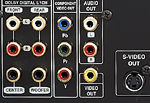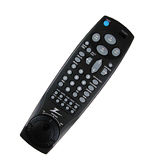Face Off: Step-Up DVD Players Zenith IQDVD2300
The last time we reviewed a Zenith DVD player, we were writing a story on the not-yet-as-ill-fated-as-it-would-become Divx feature. The player was not only one of Zenith's first DVD players, but it was one of the first with the Divx feature, as well. In all reality, we liked the player, but the general malaise toward Divx seems to have overshadowed our opinion of the player's performance. So, we decided to give Zenith another shot in this Face Off .
![]() To control the IQDVD2300, you'll have to deal with Zenith's four-function universal controller. Even with the universal functions, this wasn't necessarily my favorite remote of the group. The buttons lack symmetry, aren't within easy reach, and, in some cases, are too small for even the most deft of digits. On the other hand, the layout may be better for controlling gear other than this player.
To control the IQDVD2300, you'll have to deal with Zenith's four-function universal controller. Even with the universal functions, this wasn't necessarily my favorite remote of the group. The buttons lack symmetry, aren't within easy reach, and, in some cases, are too small for even the most deft of digits. On the other hand, the layout may be better for controlling gear other than this player.
One advantage the remote has is the "setup" button that quickly gets you into the setup mode. Sure, this seems obvious, but you look at other players and end up shaking your head. The setup menu's graphics look great. This seems to be a Zenith specialty. However, aesthetics aside, the player provides only a handful of simple adjustments. For example, the player doesn't offer the blacker-than-black information necessary to use a PLUGE test pattern. This might not affect the picture coming from the DVD player, but it could affect your ability to adjust the picture you see on your display. Also, the menu only offers level control of the internally decoded 5.1 analog audio outputs; while this is helpful if your 5.1-ready receiver doesn't also include some form of bass management or signal delay, you may have trouble. This won't, however, affect users that have a two-channel or Dolby Digital receiver.
 The Zenith player's back panel, although not packed with outputs, was as good as most panels in the group. There's the typical pair of analog audio connectors, combined with a single set of composite, Y/C, and the better-quality component outputs. The player can internally decode Dolby Digital signals and send them through the 5.1 analog output or down-mix them into a Pro Logic-compatible signal that will come from the stereo analog output. As we mentioned above, you'll be better off if your receiver or preamp has 5.1-decoding capabilities. In this case, use the coax or optical digital outputs. The player can also internally decode 24/96 signals recorded on some regular DVDs, or it will output the signal as a 16/48 signal through the digital connection.
The Zenith player's back panel, although not packed with outputs, was as good as most panels in the group. There's the typical pair of analog audio connectors, combined with a single set of composite, Y/C, and the better-quality component outputs. The player can internally decode Dolby Digital signals and send them through the 5.1 analog output or down-mix them into a Pro Logic-compatible signal that will come from the stereo analog output. As we mentioned above, you'll be better off if your receiver or preamp has 5.1-decoding capabilities. In this case, use the coax or optical digital outputs. The player can also internally decode 24/96 signals recorded on some regular DVDs, or it will output the signal as a 16/48 signal through the digital connection.
 Once we had all the connections made, we began our evaluation. Again, as with the other players, we found this one to work great, although it wasn't necessarily considered the best. I found the Zenith to be a tad brighter than the other players, something that gave the picture an immediate snap. This may be due to a slightly higher-than-appropriate output and would most likely be equalized out when your display is configured specifically for this particular player. Maureen commented that the skin tones looked very even and that closeups of Austin Powers' tea-stained teeth (ugh) looked a little too realistic. Clint felt that colors from the Zenith player were less vibrant than colors from the JVC unit, but he ranked it equal to the Samsung and Philips products. Mark thought that the Zenith had better blacks and a better overall picture.
Once we had all the connections made, we began our evaluation. Again, as with the other players, we found this one to work great, although it wasn't necessarily considered the best. I found the Zenith to be a tad brighter than the other players, something that gave the picture an immediate snap. This may be due to a slightly higher-than-appropriate output and would most likely be equalized out when your display is configured specifically for this particular player. Maureen commented that the skin tones looked very even and that closeups of Austin Powers' tea-stained teeth (ugh) looked a little too realistic. Clint felt that colors from the Zenith player were less vibrant than colors from the JVC unit, but he ranked it equal to the Samsung and Philips products. Mark thought that the Zenith had better blacks and a better overall picture.
In the end, we'll give Zenith credit for building another decent DVD player. As I mentioned, we actually liked their previous model. While this follow-up unit has a more-confusing user interface, whoever designs Zenith's menu graphics is artistically talented. The player performs well and will work great in systems that use an external Dolby Digital processor and maybe a programmable remote.
Highlights
• Four-function universal remote helps eliminate the jumble of controllers on your coffee table
• Attractive onscreen-menu graphics































































